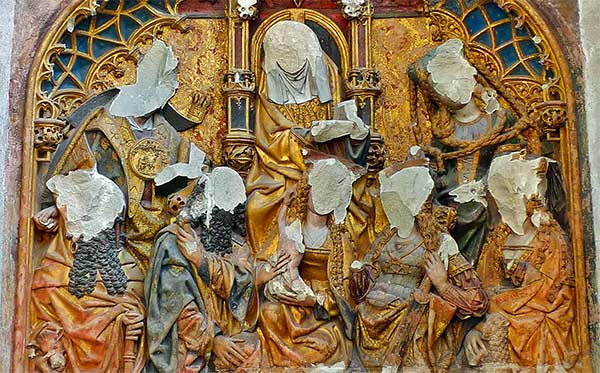“Having images in our churches is contrary to the first commandment"
“Having images in our churches is contrary to the first commandment: Thou shalt have no other gods!” (attributed to Karlstadt).

(Join us each Thursday for a fresh look at a quote from the Reformation era! Sign up via our e-newsletter (in the box at the right) or through our RSS feed (above), or follow us on Facebook for the next year as we celebrate 500 years of Reformation.)
By Jennifer Awes Freeman, Christian History Magazine Art Researcher
This fall, the Minneapolis Institute of Art is presenting an exhibit dedicated to Luther and the Reformation (http://new.artsmia.org/luther/). It is worth seeing if you’re in the area, as the Mia is the only place it will be displayed in the United States! If you are unable to attend, an excellent catalog of the exhibit will be available for purchase; as a local (and an Mia member) I will be visiting the exhibit multiple times during its run. So stay tuned for my summary, which will appear on our blog!
The relationship between theology and art is the focus of my own work as a scholar and professor—and in my spare time it also occupies my work as the image researcher for Christian History. But as the quote above indicates, this relationship is not always simple. In the twenty-first century, our images may show up on Powerpoint slides; in the sixteenth century, they were statues, tapestries, paintings, and stained glass windows. The Catholic Church interprets the first commandment cited by Karlstadt above to be not a prohibition against images, but against polytheism (worshipping more than one God). Whereas the Reformed tradition considers “you shall not make any graven image” to be a distinct (that is, second) commandment, Augustine, and the Catholic Church with him, grouped the first three statements as one, related commandment: “I am the Lord your God…you shall have no other gods before me, you shall not make any graven image,” which invites the reader to define “graven image” in relationship to fidelity to God.
In Wittenberg, Germany, college professor Martin Luther legendarily initiated the Reformation in 1517 with his 95 Theses on indulgences. Luther’s position on images in worship, however, was a lukewarm one: for him, images had neither the power to enlighten nor to ensnare. They were adiaphora: “things not critical in themselves but important only because others made them so.” For Luther, images were not (as the church had previously taught) tools of divine encounter, but they had the possibility of being tools of learning.
But not all of Luther’s fellow reformers agreed. Most notably, Andreas Bodenstein von Karlstadt used the opportunity of Luther’s hiding in Wartburg in January 1522 to preach against images and meet with other iconoclasts (people who wanted to remove images from churches and often destroyed them in the process). A rioting crowd that destroyed the images and altars of the Wittenberg church the following month seemed to point to Karlstadt. Luther returned to Wittenberg in March and forbade the further removal of images. This episode, coupled with their irreconcilable differences on the relationship between the spiritual and the material in worship, contributed to Luther rebuking Karlstadt and dismissing him as his “worst enemy.”

Defaced images in Utrecht Cathedral
A year or so after Luther’s theses, Huldrych Zwingli began to preach against the cult of the saints in Switzerland, and for good measure chimed in against images in 1522. The radical mob from Karlstadt’s Wittenberg had a strong influence on the people of Zurich: while figures like Zwingli preached vehemently against images, they also forbid vandalism and reminded their congregants that the removal of images should only be performed by the magistrate (the head of the local government).
Regardless of this care, the anti-image rhetoric won out, perhaps fueled by the precedent set by Karlstadt’s unauthorized iconoclasm. There were intermittent bouts of image destruction in the fall of 1523, which escalated after a spirited sermon by Leo Jud and the circulation of pamphlets by Ludwig Hätzer, who was influenced by Karlstadt. With so much public attention focused on the status of images, Zwingli and the authorities were left little choice but to intervene and systematically remove all of the images from the Zurich churches, leaving only the “purity” of whitewashed walls. Not every official removal of church images went so smoothly. In Basel in 1529, an impatient mob acted before the town council, smashing, burning, and painting over all the images.
In addition to issues of commandment numbering, we are left with the fundamental definition of what constitutes an “idol” and what it means to have “no other gods.” Surely, images are not the only possible idols, rather, an idol can be anything we serve in the place of God—it could even be the biblical text! But perhaps more insidious than images are the idols we cannot see or touch—our aspirations, our fears—but which have the ability to influence our daily living more than our desire to honor God.
Other upcoming exhibits in the United States include:
• “Word and Image” at the Morgan Library & Museum in New York City, October 7, 2016 to January 22, 2017 (http://www.themorgan.org/exhibitions/word-and-image)
• “Law and Grace: Martin Luther, Lucas Cranach and the Promise of Salvation,” at the Pitts Theology Library at Emory in Atlanta, October 11, 2016 to January 16, 2017 (http://pitts.emory.edu/exhibits/luther2016/index.cfm)
• “Renaissance and Reformation: German Art in the Age of Dürer and Cranach” at the Los Angeles County Museum of Art, November 20, 2016 – March 26, 2017 (http://www.lacma.org/art/exhibition/renaissance-and-reformation-german-art-age-d%C3%BCrer-and-cranach)



